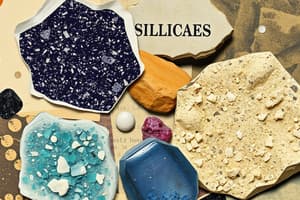Podcast
Questions and Answers
What property of a mineral does tenacity measure?
What property of a mineral does tenacity measure?
- Hardness
- Transparency
- Deformation when crushed or bent (correct)
- Taste
Which mineral reacts by producing bubbles of carbon dioxide when cold dilute hydrochloric acid is applied?
Which mineral reacts by producing bubbles of carbon dioxide when cold dilute hydrochloric acid is applied?
- Quartz (SiO2)
- Pyrite (FeS2)
- Gypsum (CaSO4)
- Calcite (CaCO3) (correct)
What are taste and magnetic properties used for in mineral identification?
What are taste and magnetic properties used for in mineral identification?
- Diagnosing certain minerals (correct)
- Determining transparency
- Measuring tenacity
- Identifying cleavage planes
Why are nearly all identifications of minerals in hand specimens made with common minerals?
Why are nearly all identifications of minerals in hand specimens made with common minerals?
Which property combination makes a mineral likely to be galena, the common lead ore?
Which property combination makes a mineral likely to be galena, the common lead ore?
Why is there little point in determining all properties of a mineral during identification?
Why is there little point in determining all properties of a mineral during identification?
What is the typical hardness range of minerals in the garnet group?
What is the typical hardness range of minerals in the garnet group?
Which property of minerals makes well-crystallized garnets suitable for use as gems?
Which property of minerals makes well-crystallized garnets suitable for use as gems?
What is a common color that garnets can exhibit?
What is a common color that garnets can exhibit?
How are minerals classified based on their physical properties?
How are minerals classified based on their physical properties?
What method is commonly used to determine the chemical composition of minerals?
What method is commonly used to determine the chemical composition of minerals?
In which type of rocks are garnets more commonly found as secondary minerals?
In which type of rocks are garnets more commonly found as secondary minerals?
Which property of minerals refers to the hardness in Mohs scale, cleavage, tenacity, and fracture?
Which property of minerals refers to the hardness in Mohs scale, cleavage, tenacity, and fracture?
What process involves the crystallization of minerals from hot solutions, as seen in fluorite and galena formations?
What process involves the crystallization of minerals from hot solutions, as seen in fluorite and galena formations?
Which property of minerals describes their brightness, luster, color, and streak when observed at a macroscopic level?
Which property of minerals describes their brightness, luster, color, and streak when observed at a macroscopic level?
What geological process involves the vaporization of highly concentrated aqueous solutions due to strong evaporation?
What geological process involves the vaporization of highly concentrated aqueous solutions due to strong evaporation?
Which type of metamorphism is associated with zones of high to moderate strain like fault zones?
Which type of metamorphism is associated with zones of high to moderate strain like fault zones?
What minerals are formed through the crystallization and deposition from aqueous solutions in 'hydatogenesis' processes?
What minerals are formed through the crystallization and deposition from aqueous solutions in 'hydatogenesis' processes?
Flashcards are hidden until you start studying
Study Notes
Mineral Identification and Properties
- Tenacity measures a mineral's resistance to breaking, bending, or deforming.
- Calcite reacts with cold dilute hydrochloric acid, producing bubbles of carbon dioxide.
- Taste and magnetic properties assist in the identification of minerals by providing unique, distinguishing characteristics.
- Mineral identifications often rely on common minerals because they are more readily available and familiar to most geologists.
- High density and cubic cleavage make it likely for a mineral to be galena, a common lead ore.
- Determining all mineral properties is unnecessary for identification; key properties usually suffice for a reliable conclusion.
Garnet Minerals
- Garnets typically range from 6.5 to 7.5 on the Mohs hardness scale.
- Well-crystallized garnets have a desirable aesthetic quality (e.g., clarity and polish) that makes them suitable for gemstones.
- Garnets can exhibit a range of colors, with red being particularly common.
- Minerals are classified based on properties such as hardness, cleavage, tenacity, and fracture.
Chemical Analysis and Formation
- Chemical composition of minerals is commonly determined using X-ray fluorescence (XRF) or electron microprobe techniques.
- Garnets are frequently found in metamorphic rocks, where they may form as secondary minerals during metamorphic processes.
- The physical properties of minerals relate to their macroscopic characteristics, which include hardness (Mohs scale), cleavage, tenacity, and fracture.
- Crystallization from hot solutions is a process seen in the formation of isotropic minerals such as fluorite and galena.
- A mineral's brightness and luster, along with color and streak, describe its macroscopic appearance.
Geological Processes
- Strong evaporation in geological settings can lead to the vaporization of highly concentrated aqueous solutions.
- Zones of high to moderate strain, like fault zones, are associated with dynamic metamorphism.
- Minerals formed from aqueous crystallization and deposition during hydatogenesis include halite, gypsum, and other evaporates.
Studying That Suits You
Use AI to generate personalized quizzes and flashcards to suit your learning preferences.




